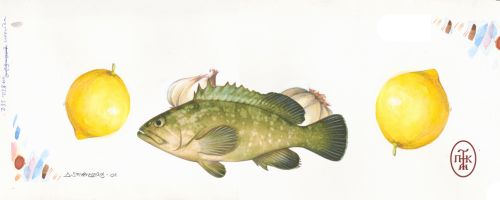
| 40 kg of salted cod, frozen, skimmed, (if we have salt-paste, then we estimate the weight of the salt it contains from our experience)1 ½ kilograms of salted, frozen, salted cod, (if we have salt-paste, then we estimate the weight of the salt it contains from our experience) | |
| 2 ½-3 kilograms of oil½ cup of oil | |
| 10 kg onions, whole4 medium onions, whole | |
| Onion juice from 4 onionsOnion juice from 4 onions | |
| 3 teaspoons of garlic, whole teeth10 garlic teeth, whole | |
| 500 γρ. celery sprouts, large5 large celery sprouts | |
| 1 monohoft fine saltfine salt | |
| 1 wine cup of pimento pepper1 teaspoon of pepper, grated | |
| 1 ½ kg natural lemon juice1 cup of coffee natural lemon juice | |
| water (as much as needed)water (as much as needed) | |
| 1 tablespoon of chopped parsley, for garnish |
| 1. | Boiling: |
| 2. | We take a suitable dhava, depending on the amount of food. |
| 3. | Lay out the portions (pieces) of cod, each piece next to the other so that they all fit in the dava. |
| 4. | That is, place the portions in such a way that one rests on the back of the other and in a circular manner, starting from the periphery towards the centre of the dhava. |
| 5. | Place a few celery in the centre of the dava and on top of them the 3 large onions, which we kept whole. This is because a lot of heat develops in the centre so that the onions can absorb it and not destroy some portions of fish. |
| 6. | If some pieces don't fit, throw them on top as a second layer, no problem. |
| 7. | Add the onion juice until the fish is well covered and has 4 inches of onion juice on top. |
| 8. | If we have experience, the juice will be just right for us. If necessary, add a little water. If we have leftover, we keep it in the freezer for another use. |
| 9. | Cover the dava and put it on the fire. |
| 10. | After about 15 minutes it starts to boil. |
| 11. | As soon as it starts to release its dirt (foam), skim it with a flat-bladed slotted spoon and discard it. |
| 12. | When the foam has been removed, add the garlic, celery, oil and pepper to the dava and cover and bring to a boil. |
| 13. | At regular intervals, move the pulley left and right to prevent the fish from getting stuck and watch it closely. |
| 14. | After 40 minutes you should probably remove the lid of the dava completely, because it will stick. |
| 15. | It takes a maximum of 1 hour to boil. |
| 16. | Towards the end of the boiling, the fire should be less and the movements to the right and left of the pasta are necessary to prevent the portions from sticking. |
| 17. | Check the amount of stock to be served and if it is not enough, add a little water. |
| 18. | Now adjust the salt if necessary, tasting the stock. |
| 19. | In practice, you should see the fish portions almost covered. |
| 20. | Five minutes before removing the dava from the heat, pour the lemon juice over the surface of the fish. |
| 21. | Shake vigorously until the lemon and fish juices are combined and remove from the heat. |
| 22. | Do not cover the dava until it has cooled down a little. |
| 23. | When serving, sprinkle some parsley on top. |
| 24. | It is served and eaten hot. |
| 25. | Pour the material back into the hole and repeat the same process until they are completely drained. |
| 26. | Onion juice: |
| 27. | Several hours before cooking (even the day before), prepare the onion juice. |
| 28. | Put all the onions (except for three large ones) cut into three pieces in a similar container, along with a little salt and 50 g of oil. |
| 29. | Pour water until they are very well covered, 7 inches above them, and put them on the fire to boil. |
| 30. | Let them boil for about an hour, stirring periodically. |
| 31. | When they boil, their water should be almost half full. |
| 32. | Once they have cooled down, pour a few of them into a large hole that you have in a bowl to collect the juice. |
| 33. | Mix very well until at least half the amount of the melting remains in the hole. |
| 34. | Then pour the rest of the crushed onions into another bowl. |
| 35. | Add a little water, just enough to dilute the material and mix very well to extract the juices. |
| 36. | Then discard the rest of this onion material and keep the drained juice. |
| 37. | Tip: |
| 38. | We always add more kilos of fish because some portions may spoil during cooking or serving, so it's good to plan ahead. |
| 39. | The proportion in each portion should be rich, around 200 grams each, because there is no accompaniment to the Athonite, e.g. potatoes, pumpkins or carrots etc. |
| 40. | Be careful because of the juices of the fish and the onion it sticks very easily, so watch it closely throughout the boiling process. |
| 41. | When the fish is cooked we see it dancing, literally, in the dava and if we blink our hand over the steam, we find that it sticks. |
| 42. | Instead of lemon, you can use tomato paste with a little sour, dissolved in a little water or fish stock. In this case, allow more time for the sauce to unify by adding the sauce earlier. The taste in both options is equally wonderful. |
| 43. | The salted cod is one of the most beautiful monastic Athonite dishes. It is customary in the winter season and despite its bitter value, it is eagerly consumed. |
